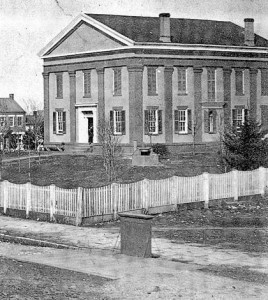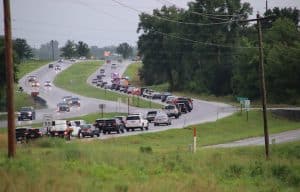Monroe County saw population boom in mid-1800s

Monroe County’s second courthouse, completed in 1853, still stands today as the center section of the older half of the courthouse. The box-like device at the street’s edge was part of the public scale where wagons of farm products and other items could be weighed for sale.
This is the third installment in a monthly series looking back on Monroe County as part of its Bicentennial celebration in 2016. This piece examines the period from 1840 to 1860.
By 1840, Monroe County was almost ready to celebrate a quarter century as a county, first of the territory and then state of Illinois. Its population was officially 4,481 in the U.S. Census that year. Two decades later, in 1860, as the nation approached the tragedy of the Civil War, that figure nearly tripled to 12,832 residents.
A substantial part of this growth was due to immigration from Europe, which was heaviest from 1840 to the mid-1850s. Germans settled in Columbia and Maeystown, with a large push from there after the failed revolution of 1848, during which more liberal Germans sought to democratize their government.
Called 48’ers, many of that country’s best and brightest gave up on futures there and moved to the United States.
Immigration from Europe to Monroe County saw an added push when a crop failure known as the Great Potato Famine gripped Ireland and forced its people to either move or starve.
Today, we still see strong ties between areas of Germany and Monroe County, including a strong sister cities partnership.
Numerous churches arose in the region during that period as well. Baum Salem and Zoar churches were among them, as were Catholic parishes in Waterloo and Columbia. Many of the churches established in the 1840-60 period still exist here, perhaps with different names, like the United Church of Christ group that grew from a merger between the Evangelical and United and Congregational churches.
Midway through the period being explored this time, in 1851, a second courthouse was started in Waterloo. Although there is no known picture or drawing of the first one, at the sight of today’s bandstand, you don’t need a picture to see the second one, finished in 1853. That’s because it is the center section of the old part of today’s courthouse. The two wings on the north and south sides were added in 1907.
The assessor’s office, part of the mapping and platting office and board of appeals room occupy the oldest part of the first floor of the second courthouse, and the old upstairs courtroom rounds out the oldest section that is open to the public. A basement area is today used for records storage.
Two communities that continue to exist today were founded in this period, as well. They are Maeystown in 1852 and Columbia in 1859.
Numerous post offices also came into existence in this two-decade period, with one of the earliest being the Eagle Cliff Post Office in a settlement of the same name at the foot of the bluff below where Miles Cemetery is today.
History tells us the first newspaper here was published in Waterloo in 1845. It was named the Independent Democrat.
While rapid growth was a feature of the era, one thing that has gotten smaller since then is the roster of road districts. Today, 10 such entities maintain roads across the county’s 398 square miles (minus 12 square miles covered by water). In the period being considered, there were as many as 39 districts.
By the end of the era, national tensions between the north and south – slave and free states – were growing. They did so in Monroe County as well. They never dominated the time, though, because while there were a small number of former slaves and slave owners living here, mostly farming in the bottoms, the region was predominately Union in its sympathies.
In fact, when Confederates sought to take over the armory at Jefferson Barracks in Missouri, many Germans from this area took up arms as part of the volunteer force that prevented this from happening. Many of the county’s former European settlers served in the Civil War, predominantly on the Union side. Today, there are more than 100 graves in the county, holding the remains of service members who fought in the war.
Watch for our next installment, when we take up the period from 1860, including the Civil War and its aftermath up to 1880.
County history book
This monthly summary of Monroe County’s history, in 20-year segments, barely scratches the surface.
If you want to get the detailed, comprehensive version of what has happened in two centuries, reserve a copy of “From Tablet to Tablet: Monroe County, Illinois, 1816-2016, 200 Years of History.”
This historical treatise will cover some 1,000 pages in two volumes in a slip cover box. It can be ordered for $50 by cash or check, to the Monroe County Bicentennial Committee, c/o Dennis M. Knobloch, County Clerk, Monroe County Courthouse, 100 South Main Street, Waterloo, Ill. 62298.
Each set will be individually numbered inside the cover. You may want to consider capturing sets for children as well, so they don’t have to fight over yours.






